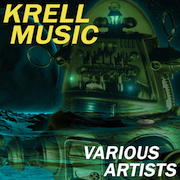The cheapest high in Electronic Music may be had by making unstructured noise. Typically, composers who partake in this kind of exercise are asking of the listener nothing more than, "I dare you to like this" - as only the author alone can appreciate their own impenetrable musical acts. While the works found on Krell Music (119'49") may indeed pose challenges to the average music consumer, the concept enlivening this collection is of the first order - and excellently informs each and every piece with its mission.
The Krell referred to in the title of this anthology will be well-known to fans of Forbidden Planet, the beloved 1956 cult-classic of Sci-Fi cinema. As the story unfolds, we discover that The Krell were the once a thriving alien race inhabiting the distant planet Altair IV - the only remaining evidence of their existence being their abandoned, monumental engineering achievements and equally impressive examples of art, culture, and music. Krell Music features imaginative extrapolations of the brief example "Ancient Krell Music" presented in the film's soundtrack - which was realized by EM pioneers Louis and Bebe Barron. Their music, which is heard throughout Forbidden Planet, lacks real-world references, so as to sonically represent the fantastic objects and beings discovered in the movie - yet still managed to serve conventional narrative demands. It is also credited as the first all-electronic score ever to be employed in a Hollywood film.
The reverence shown to the Barron's by generations of Electronic Musicians borders on the religious, as their amazing efforts are often thought of as the starting point of a continuing, decades-long, amazing experiment. Their early "electronic tonalities" envisioned how EM evokes notions of the exotic Other, and reset every fundamental aspect in scoring a film. This is what outer space sounded like, and still sounds like over 60 years on.
Krell Music will confound anyone with an expectation of continuity. Each track, whether imagined out of the reference scene, or absorbed in the energy of the soundtrack as a whole, is missing any conventional access point. Without discernible rhythm, consonant melody, or even a tonal base, these realizations touch something deeply primitive that lives within us all. Telling their story simply through the manipulation of sound, the contributors have come up with compositions closer to the ideals of modern abstract painting than of music. Arranging sounds without any terrestrial reference, each track transpires into a surreal, unknowable atmosphere.
The instruments used to produce this music must have gotten a real workout - as the sounds they emit cover a wide range of imaginative sonorities. From the nightmare texture of tensile sonics and arcane modulations, to gentle lullabies and the quiet humming of The Great Machine, the 26 musicians represented here all have their own individual idea as to what the music of the Krell meant and sounded like. This group has absorbed well the film's meaning and place in history, and even more so the aesthetics of its music.
The collection of music presented here should be considered masterful. Krell Music works both as a stunning document of a fictitious lost alien civilization, and a 26 track soundtrack of unlovely, but not unloved music (for which your attention to all will be rewarded). Yet within all the clatter may be found a questing optimism. Because, as old as it is, the genre of Electronic Music is not yet done teaching us what it can do.
- Chuck van Zyl/STAR'S END 8 November 2018
